
 CONSTITUTION DAY
CONSTITUTION DAY
BOOKS, LESSONS, AND RESOURCES
| Compiled by Jacqueline Jules www.jacquelinejules.com |
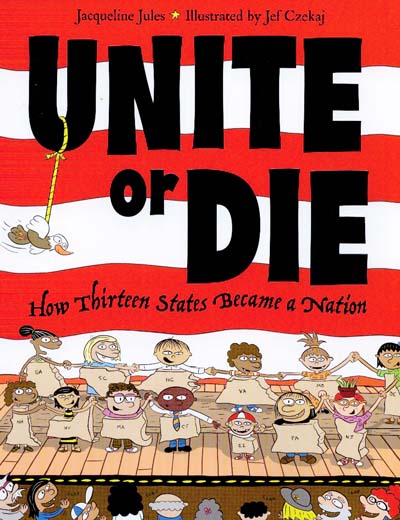
Since 2005, Public Law 108-477 has required public schools to provide an educational program on the U.S. Constitution on September 17th, Constitution Day. The U.S. Constitution and the birth of our unique brand of democracy are also an integral part of American history curriculums and essential knowledge for most standardized tests. How do you make these lessons into lively, engaged learning experiences instead of snooze fests? Here are some resources and ideas.
SHARE THE DRAMATIC MOMENTS: In the years after the Revolutionary War, the thirteen original states behaved like squabbling siblings. They refused to honor each other’s money. They fought over land boundaries and river rights. Most people considered themselves citizens of a particular state, not the United States of America. When Daniel Shays led a rebellion in Massachusetts, the other twelve states essentially said, “Sorry, you’re on your own.” The Articles of Confederation made the national government headless and hopeless. In the July heat of 1787, the founding fathers realized that a new government was needed to keep the country from collapsing. However, the delegates came to a bitter impasse over the issue of representation in Congress. Benjamin Franklin called for prayer, and George Washington looked haggard, as if he were reliving the terrible days at Valley Forge. If the delegates had not reached a compromise, it is possible that the United States of America would be an historical footnote, not the powerful country it is today. Emphasizing the urgency behind the Constitutional Convention should incite student interest.
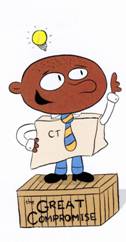
My book, Unite or Die: How Thirteen States Became A Nation, presents the conflicts between the states before 1787 and climaxes at the pivotal point during the convention when the delegates accepted the Connecticut Compromise proposed by Roger Sherman. Having overcome the major stumbling block of representation in Congress, the delegates proceeded to establish a framework for a new democratic form of government. The U.S. Constitution is exceptional for its checks and balances. The founding fathers were careful to create a government based on compromise, where no one branch could dominate the other. Even more ingenious, they realized the need for growth and change. The Constitution is a living document, designed to serve our country from generation to generation. Constitution Day is an opportunity to teach our children how carefully our form of government was crafted, and to take pride in American democracy. Other child-friendly books on the subject include Shh! We’re Writing the Constitution by Jean Fritz, American Documents: The Constitution by Paul Finkelman, We the People: The Story of Our Constitution by Lynne Cheney, and Constitution Construction by Bentley Boyd.
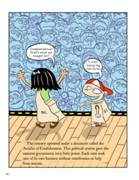
PUT ON A PLAY: Students love to participate, and reader’s theater gives them a great opportunity to show off their speaking and reading skills.
Unite or Die: How Thirteen States Became a Nation has a downloadable Reader’s Theater for classroom use.
Reader’s Theater Scripts on the Constitution can also be found in the following teacher materials:
Reader’s Theatre for American History by Anthony D. Fredericks (“The Delegates Speak Out.”)
The Constitution of the United States by Teacher Created Materials.
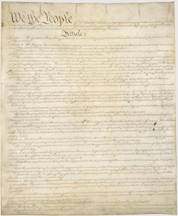
SHOW THE DOCUMENT: You can buy a poster or a replica of the U.S. Constitution or you can download the image from http://www.archives.gov/ If you print off copies on gold parchment paper and encase them in plastic sleeves, the students can examine the document in pairs. Talk about what the Constitution looks like. It’s handwritten and old. Let them examine the signatures at the end. Do they recognize any of the names? And spend some time discussing how “We the People” is larger than any other words on the page. Why did the founders begin with the words “We the People” and why did they make those words so large? What do they mean? Do these three words signify a particular kind of government?
After the students see a copy of the Constitution, read aloud We the Kids by David Catrow. Discuss what a preamble is. Analyze the reasons the founders listed in the Preamble: establish justice, insure domestic tranquility, provide for the common defense, promote the general welfare, secure the blessings of liberty. Ask students if they agree with those reasons for government. Would they add anything? Do they think one reason is more important than another? Do they agree with the order in which the founders listed those reasons? Have students vote on which reason for government they feel is most important.
For another great Preamble activity, go to http://bensguide.gpo.gov/9-12/games/preamble_scramble.html for the PREAMBLE SCRAMBLE.
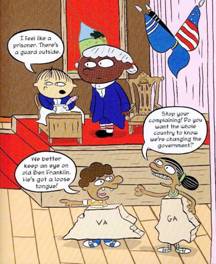
CREATE A MOCK MEDIA EVENT: The Constitutional Convention operated without the distraction of the press. Delegates were free to debate the issues hotly and to change their minds if they wanted. The merits and downfalls of secrecy should be discussed in the classroom. Would the outcome have been different if delegates were worried about public opinion? Does the press influence how our politicians behave today? Do the people deserve to know what’s going on? How can an unbiased report be preserved for history without the press?
However, on the day the Constitution was signed, September 17, 1787, reporters did have access to the delegates. Divide the class into groups of two to do research on a convention delegate. Good resources for this include the general encyclopedia, Founders: The 39 Stories Behind the US Constitution by Dennis Brindell Fradin, and archives.gov, which has great biographical information on the delegates. http://www.archives.gov/exhibits/charters/constitution_founding_fathers.html
One student from each group should prepare questions as a reporter standing outside Independence Hall, wondering what is going on inside and waiting to greet key convention figures, such as James Madison, George Washington, Benjamin Franklin, Alexander Hamilton, and Roger Sherman. The other student should play the role of a convention delegate, dressing the part as well. Interview questions could include: Why all the secrecy? What was the most difficult hurdle to overcome? Why did you come to the convention? What was your role? Do you think the American public had the right to know more about the convention proceedings?
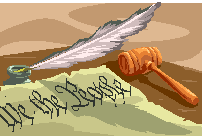 |
WEB RESOURCES for CONSTITUTION DAY: |
Constitution crossword puzzles can be found on CONSTITUTIONFACTS.COM
http://www.constitutionfacts.com/index.cfm?section=funZone&page=crosswordPuzzles.cfm
The Center for Civics Education has downloadable Constitution Day plans for K-12
http://www.civiced.org/index.php?page=constitution_day
Congress for Kids has a nice overview of the Constitution with online quizzes
http://congressforkids.net/Constitution_index.htm
Archives.Gov has lessons for Constitution Day appropriate for middle and high school
http://www.archives.gov/education/lessons/constitution-day/
EDSITEMENT has lesson plans for Constitution Day for upper elementary and above
http://edsitement.neh.gov/constitution-day/teachers
EDUCATION WORLD has a nice overview of online Constitution Day Resources
http://www.education-world.com/a_lesson/lesson/lesson347.shtml
BEN’S GUIDE TO HISTORICAL DOCUMENTS has great info for elementary age kids
http://bensguide.gpo.gov/3-5/documents/index.html
SCHOLASTIC has a Constitution Game and a mock interview with Benjamin Franklin
http://teacher.scholastic.com/scholasticnews/indepth/constitution_day/index.asp
www.jacquelinejules.com